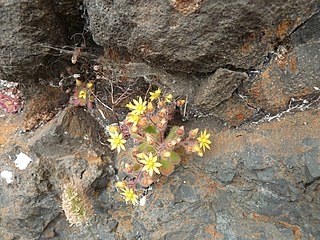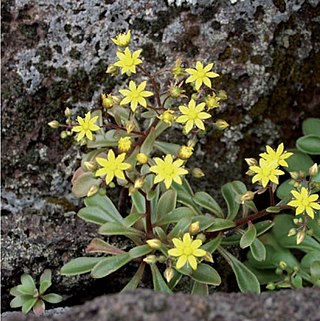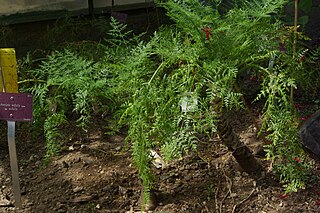
Madeira, officially the Autonomous Region of Madeira, is one of two autonomous regions of Portugal, the other being the Azores. It is an archipelago situated in the North Atlantic Ocean, in a region known as Macaronesia, just under 400 kilometres (250 mi) to the north of the Canary Islands and 520 kilometres (320 mi) west of the Kingdom of Morocco. Madeira is geologically located on the African Tectonic Plate, although its people are descended from Portuguese settlers. Its population was 251,060 in 2021. The capital of Madeira is Funchal, which is located on the main island's south coast.

Aeonium, the tree houseleeks, is a genus of about 35 species of succulent, subtropical plants of the family Crassulaceae. Many species are popular in horticulture. The genus name comes from the ancient Greek αἰώνιος / aiōnios (ageless). While most of them are native to the Canary Islands, some are found in Madeira, Cape Verde, Morocco, in East Africa and Yemen.

Aichryson is a genus of about 15 species of succulent, subtropical plants, mostly native to the Canary Islands, with a few in the Azores, Madeira and Morocco.

Myoporum laetum, commonly known as ngaio or mousehole tree is a plant in the family Scrophulariaceae endemic to New Zealand, including the Chatham Islands. It is a fast growing shrub, readily distinguished from others in the genus by the transparent dots in the leaves which are visible when held to a light.

Lobularia maritima is a species of low-growing flowering plant in the family Brassicaceae. Its common name is sweet alyssum or sweet alison, also commonly referred to as just alyssum.

The Madeiran large white is a subspecies of the large white butterfly, endemic to Madeira. It was described by the English entomologist, Arthur Gardiner Butler in 1886.

Alphitonia ponderosa is a species of flowering tree in the family Rhamnaceae, that is endemic to the Hawaiian Islands. It is locally known as kauila, as is the related Colubrina oppositifolia.
Myoporum stokesii is a plant in the figwort family, Scrophulariaceae and is endemic to the island of Raivavae in French Polynesia. It is similar to the two other members of its genus on the island, Myoporum rapense and Myoporum rimatarense although the former has serrated leaves and the latter has wider leaves and differently shaped fruits.

Sideroxylon mirmulans, commonly known as marmulano, is a species of flowering plants in the family Sapotaceae. It is endemic to the Madeira Islands (Portugal). It is threatened by habitat loss.

Aeonium glutinosum is a species of flowering plant in the family Crassulaceae endemic to Madeira, Portugal. It has fairly thick leaves and its appearance varies depending on its growing conditions. One characteristic is the very sticky stem of the inflorescence. The main flower is shown but small stalks with flowers continue to appear for several months.

Myoporum petiolatum, commonly known as sticky boobialla, is a plant in the figwort family Scrophulariaceae, and is endemic to the south-east of continental Australia. For many years this species has been confused with the much less common species Myoporum viscosum from which it can be distinguished by its thinner, noticeably petiolate and non-odorous leaves.
Myoporum crassifolium is a plant in the figwort family, Scrophulariaceae. It is a shrub or small tree with thick, fleshy leaves and small groups of white flowers spotted with pink or purple. It is endemic to New Caledonia, Vanuatu and the Loyalty Islands and is a rich source of the essential oil, bisabolol.

Aichryson villosum is a species of herbaceous flowering plants in the family Crassulaceae endemic to the Madeira Archipelago. The species was first described by Sabin Berthelot and Philip Barker-Webb in 1840, published in Natural History of the Canary Islands. Aichryson santamariensis was previously included in this species, but is now considered a different species endemic to Santa Maria Island, Azores.

Pterostylis divaricata, commonly known as northern striped greenhood, is a species of orchid endemic to northern New South Wales. It grows in colonies of genetically identical plants. As with similar orchids, plants in flower differ from those that are not. Those not in flower have a rosette of leaves that lie flat on the ground. Plants in flower lack a rosette at the base but have up to ten translucent white flowers with green and brown stripes. This greenhood is similar to P. striata but has larger flowers and a longer tip on the dorsal sepal.

Gunnera petaloidea is a species of Gunnera endemic to Hawaii on the islands Oahu, Molokai, Maui, and Hawaii. It is found on slopes which receive torrential precipitation at an altitude between 2,500–5,000 feet (760–1,520 m). The Hawaiian name for this plant is Apé or Apé-Apé.

Leptospermum divaricatum is a species of plant that is endemic to inland New South Wales. It is an erect or weeping shrub with compact fibrous bark, elliptical to egg-shaped leaves, white flowers arranged singly on short axillary side shoots and woody fruit that fall off when mature.

Aeonium glandulosum is a species of subshrub of the family Crassulaceae endemic to the Madeira archipelago.

Aichryson dumosum is a critically endangered species of succulent plant of the family Crassulaceae endemic to Madeira.

Daucus edulis is a critically endangered species of flowering plant in the celery family Apiaceae. It is endemic to Madeira.
Aichryson santamariensis is a species of plant endemic to the island of Santa Maria in the Azores. This species was previously part of the similar Aichryson villosum, restricted now only to the neighboring Madeira.


















